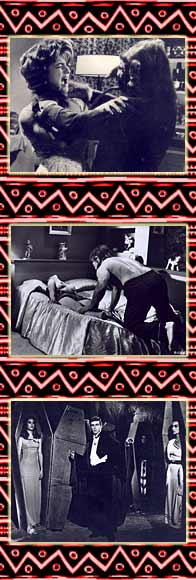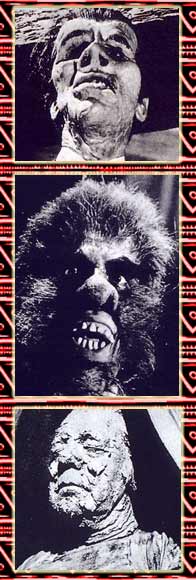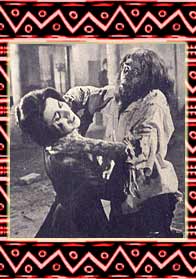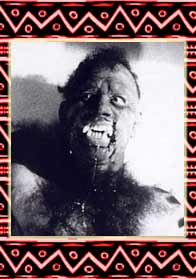 |
 |
|
My first experience with a Mexican horror film came sometime in the mid- seventies. It was a Saturday morning, and my speculation is that channel 9 was showing the film. My Mom was watching the film with me, I liked to isolate myself and watch movies a lot when I was a kid, this concerned people a bit, so my Mom was acting as the surrogate friend I did not need. Any how, before my very eyes, unfolding on the screen, was THE BRAINIAC (1961). From the minute the film started, I recall being captivated. The plot started somewhat like the classic Vincent Price films I was used to watching. A Warlock (Abel Salazar) was to be executed by the Spanish Inquisition, for doing unlimited evil deeds. In what has to be one of the most idiotic plot holes in the history of cinema, the Warlock displays his powers to the magistrates, by making the chains that bound him disappear. Yet, sentencing is pronounced, he is to burned alive, and this buffoon walks to the stake to be burned ??? Why didn't he disappear himself ? Why not wipe out the whole court with just a wave of his hand ? This is a sudden lack of logic that will make most Mexican horror films very endearing, sort of like the lovable kid with downs syndrome who lives down the block. It's funny, when Americans make stupid scenes like the one I just described, I usually hit the ceiling, I find it unforgivable. But when the Mexicans do it, I just break into a smile. You expect it, if they don't do it your shocked. Anyhow, the guy is burned, but threatens to return in 300 years, with the passing of an overhead comet, that looks like something out of a grade school play. Bear in mind, I'm riveted to this film, nothing has my attention but the tube. Anyhow, he does come back to seek revenge, but not as a reincarnated fiend, like Vincent Price in The Haunted Palace (1963), but rather a monster from space, a fucked up looking Demon complete with elongated, forked tongue, which he uses to suck out the brains of his enemies. Believe me friends, up to this point in time, I had never seen such a cool, original monster in my whole life. Here I was used to the Universal monsters, Drac, Frank, and the boys. Then, here comes this creature, it's head literally pulsating, chasing after people in order to jam his tongue down the backs of their head ! Unfucking believable. I can't quite recall my Moms reaction when she saw this thing, but I do recall her being speechless, and chuckling every once and a bit. The interesting thing about this monster is that long term exposer of any monster suite is usually not good. But this film baths in the monsters presence, the makers of this mask were proud! This was what a young fella like myself needed, constant exposer to what I perceived to be a really cool creature, plus I was obsessed with "getting revenge", I hated my school peers and viewed them as the Inquisitors in this film, with myself as the martyr turned monster.
My next experience with this genre came via THE CURSE OF THE DOLL PEOPLE (1960) without a doubt one of the spookiest pieces to have graced my eyes at the time. Again, I'm quite certain, my Mom was in the room, keeping a close eye out for the first signs of Autism. Anyhow, the story of a voodoo curse being forefilled by the use of dolls inhabited by stolen souls was a creepy premise, made all the more disturbing by the dwarf actors dressed in hideous doll costumes. These hideous dolls where dropped off at each victims house by an ugly, mute zombie, who stayed hidden in the dark. As the intended victim would go into bed, the zombie would sit below the window of the doomed person, playing a spooky flute tune. Then, the doll would come to life, and usually stab or strangle the victim. All I can say is I saw this film shortly after Brainiac, and I was blown away. Then, to consolidate my new found treasures, I had a Famous Monsters Magazine that told all about these spicy south of the boarder offerings, and now I could truly identify just where these film were from, who made them, and who the stars were. So fascinated was I with this interesting "new" cinema I had come across that I began to seek it out. I recall distinctly perusing the TV guide, even keeping my eye on the local Spanish speaking station, channel 47, and hitting pay dirt when they showed Santo En La Venganza De La Momia (1967). Bear in mind I don't speak a word of Spanish, but what did I care, here was my first exposer to Mexico's equivalent of Superman, Santo, and his battle with the Aztec Mummy, which concludes in a disappointing manner when the mummy is revealed to be some jerk in disguise, none the less, a very engaging piece of cinema. The scenes involving the phoney mummy stalking a group of treasure hunters is indeed very spooky, and the mummy using a bow and arrow for a weapon indeed add an interesting twist to the proceedings. These where the grand old days of the early seventies, everything seemed so innocent and cozy to me, then came the eighties, and out went my innocence and the security I was so used to. In the early eighties, I was busy perusing the local theatres, watching such garbage as The Prowler (1981), Nightmare (1981), as well as early guinea gore like Gates of Hell (1984) and House By The Cemetery (1984). There was so much good trash coming out in the theatre, that it was likely I'd attend a picture three or four times a week. Now, two very interesting things happened in the early eighties. Number one, Rene Cardona Sr's NIGHT OF THE BLOODY APES (1969) was re-released to theatres in '82. The interesting thing is that I DID NOT get to see it! Why, you may ask? Well, for one, the title. It's true, I could not talk a single friend in to attending this film with me, then , when my gal friend and I went to a matinee show of some other flick that was sold out, I noticed that NOTBA was playing, and I tried like mad to convince her to go. When she would not relent, I asked her why. And all she said was "that title, I hate it". What the fuck! By the time I was ready to go it alone, the flick was gone. And to add insult to injury, when the film finally came to video in the mid eighties, I wanted to rent it, but my pal, Paul Richichi, did not, and when broached about why, he relented "I don't like the title", and "the guy on the box reminds me of my wife's cousin". The guy on the box was the apeman from the film! Well, I finally rented it myself one day, and just as I was about to watch it, Richichi popped over, ended up watching it, loved it, and needless to say it's now one of his favorite films. Hence, never judge a book by it's cover. For the lame among you, NOTBA is an example of Mexi-cinema totally out of control, a flick that Cardona shot two alternate versions of, a soft version for the general public, and a harder version for overseas. It was the harder version that hit these shores in '72, and rumor has it that the American distributer spiced it up with extra sex and violence as well. And because of the gore quota, this film made for a natural re-release choice during the early gore soaked eighties. On top of that, our local cable station gave us the U.S.A. network, which, on Saturday afternoons, gave us Commander U.S.A., some idiot in a cape who liked like Pat Harrington, had a face painted on his pinky which he called "his friend Lefty", and showed many God awful horror movies. On this station I saw THE VAMPIRES COFFIN (1958) the classic sequel to the equally classic THE VAMPIRE (1957). Again, producer Abel Salazar appears as the unwilling hero, fighting Count Lavud (German Robles), a noble man from Europe who sports a Jewish star on his coffin. Salazar plays his role for laughs, coming off like a dime store version of Bob Hope. The visual effects in this flick rock, highlighted at the end when Salazar and Robles do battle. Robles appears and disappears, finally getting staked while in the form of a monsterous bat! Director Fernando Mendez has so much talent that he makes up for the rest of the talentless directors in the united states. Basically, the Commandeer showed the bulk of the Mexican horrors, but I had a girlfriend at this point and was much more interested in getting blowjobs rather than watching these films, which in a way was a shame, cause the films are no longer shown on TV and blowjobs are a dime a dozen.
At this point, I had discovered the joy of tracking these films down in their original, Spanish language versions. Not to say that K. Gordon Murray did a bad job in distributing these films to an English speaking audience, but of course the Spanish language originals by far present the acting, and the overall appearance of the films in a more serious light. Prime example, take my version of MISTERIOS DE ULTRATUMBA (1957), known in this country as The Black Pit of Dr. M. Perhaps one of the most surreal films to come out of Mexico, a film far more like the product associated with German silent cinema. All Hell breaks loose when two scientist make an agreement that upon death, one will return to tell the other about the experience of dying. In a seance, the dead doctor tells the other that he will soon know for himself the event of death. And when the living doctor ends up being accused of murder, and is executed, his disfigured corpse returns to seek revenge on the other dead scientists daughter. If your confused, don't worry about it, because director Fernando Mendez creates are funeral lyricism so stark in it's use of light and shadow, that dubbing the film should be of little consideration. Of note, the dubbed version, Black Pit of Dr. M has yet to surface on video, so my Spanish print is the only one available. The sight of the decaying scientist playing his violin in the dead of night is both pathetic and brilliant, pathetic in that the doctors curiosity has bit him in the ass and landed him in this horrible situation. Brilliant in that it puts him in a "Phantom of the Opera" light, sort of a tragic hero. Mendez's three films (The Vampire, The Vampires Coffin, and Black Pit of Dr. M ) fall into a completely different category of Mexican cinema in that they take their subject matter very seriously, while other films tend to get more comical in their absurdities. On the more absurd side I present for your viewing pleasure EL MUNDO DE LOS VAMPIRES (1960), (English translation, World of the Vampires).This piece of fluff features Vampire men with Bat heads, vampire chicks with silly eyebrows that look like Lilly Munster, and plenty of atmospheric crypt scenes. The bat men are great, doing some sort of strange Ti Chi' move in unison, those cardboard masks stiff as a beer boner at six in the morning. The guy playing the vampire is no German Robles, and in fact looks sort of goofy in a sixties, fad hairstyle kind of way. Some of the Mexican chicks in the flick are kinda hot, so it's keeps your attention off the goofball vampire, if you're a male, anyhow. Keeping up in the grand tradition of goofiness, why not check out Mexico's answer to Journey to the Center of the Earth, in this case called ADVENTURES AT THE CENTER OF THE EARTH (1958). Again, I offer the original, Spanish language B/W print, but language is no barrier for this one. When some tourists disappear during a tour of a cavern in Mexico, a research team sent to investigate discovers monster snakes, and killer bat men in what has to be one of the most delirious adventure films ever made. First off, let me say that Herschel Gordon Lewis did not introduce the gore film to this country. The Mexicans where fucking with cinematic violence in the fifties, this film being a prime example as victims of the bat creature end up with ghastly, oozing throat wounds. The bat man himself is really something to set eyes on. In long shots, it a silly plastic mask, somewhat similar to the ones used in World of the Vampires. But in close-up, it seems the filmmakers did not like the look of the mask, hence they substitute a guy in Jack Pierce style make-up grimacing and making a general fool of himself. But the difference between the mask and the make-up is startling, they would have been better off with one or the other, but using both only makes one think that the folks who put this film together must have ingested way to much peyote. Still, in the area of pure entertainment, you've never had a better 90 minutes. It's interesting to note that as the horror film in Mexico develops in it's popularity, the productions become rushed, yet despite certain areas of incompetence, such as writing, make-up, direction, there still seems to be some degree of professionalism, whether it be in the camera work, lighting, etc... which in itself lends to the disjointing experiences of watching these films. And no two really seem alike, except of course for that inevitable mark that you are watching something foreign, strange, and sinister. In fact, a nice co-feature for Adventures at the Center of the Earth would be MONSTER OF THE VOLCANO (1964), Mexico's odd ball take on the Yeti legend. Again, I offer the Spanish language original which gives us the most ridicules Yeti this side of the Himalayas. Basically little more that a fat man in a dyed white gorilla suite, this Yeti has the power to hypnotize folks into carrying out his orders, and as he projects his thoughts into his victims heads, he comes across with the clearest, most commanding voice this side of Fernando Lamas. Why this creature, with the ability to live in high, snowy altitudes, and possessing intense strength, would need humans to carry out things is beyond me, but I guess it is no more absurd than Dracula needing Frankenstein to carry out his dirty work. A bit talkier than the others, this film is still worth adding to your collection, mostly for the very unscary Yeti who thinks like Albert Einstein.

|
 Mexi-Monsters on the March - By Keith Crocker
Mexi-Monsters on the March - By Keith Crocker The point is this, and if you get anything out of this fuckin article, let it be this, the understanding of why these films work! Very simple. Simplicity. They are designed totally to entertain the poor and working class, hence, the bulk of Mexico. So of course, having seen this stuff as a kid, the click was instantaneous, what's not to like? Now, in terms of whether or not Mexi horror cinema helps improve the strife of the living, well, no, it's counter revolutionary, and follow me on this. For one, it's pro Catholic church, which encourages poverty and martyrdom in favor of , God for bid, a Communist or Socialist revolution. Masked Wrestlers are the true heros, not revolutionaries. The Monsters (aka the radicals), are always thwarted by either good Christians or idiotic wrestlers (wrestling is a big industry in Mexico, a revered profession, something the youngins look up to). And it maintains the fear that anything NEW is DANGEROUS! Of course, we cannot look at these films in the same light we examine Bunuel or Juan Lopez Moctezuma, but, they ARE INNOCENT in their escapism, and while they didn't promote a different way of living, they did keep a lot of overworked and under appreciated folk happy, and that same joy comes to this "rapidly falling into a third world country", country, itself. That's right, my working class anxieties were quickly put to rest by these smile inducing films. Let me continue the story...
The point is this, and if you get anything out of this fuckin article, let it be this, the understanding of why these films work! Very simple. Simplicity. They are designed totally to entertain the poor and working class, hence, the bulk of Mexico. So of course, having seen this stuff as a kid, the click was instantaneous, what's not to like? Now, in terms of whether or not Mexi horror cinema helps improve the strife of the living, well, no, it's counter revolutionary, and follow me on this. For one, it's pro Catholic church, which encourages poverty and martyrdom in favor of , God for bid, a Communist or Socialist revolution. Masked Wrestlers are the true heros, not revolutionaries. The Monsters (aka the radicals), are always thwarted by either good Christians or idiotic wrestlers (wrestling is a big industry in Mexico, a revered profession, something the youngins look up to). And it maintains the fear that anything NEW is DANGEROUS! Of course, we cannot look at these films in the same light we examine Bunuel or Juan Lopez Moctezuma, but, they ARE INNOCENT in their escapism, and while they didn't promote a different way of living, they did keep a lot of overworked and under appreciated folk happy, and that same joy comes to this "rapidly falling into a third world country", country, itself. That's right, my working class anxieties were quickly put to rest by these smile inducing films. Let me continue the story...  In the late 80's, an ex-friend turned me on to the brilliant
In the late 80's, an ex-friend turned me on to the brilliant  In the area of outrageous over the top horror, you can't beat Baledon's
In the area of outrageous over the top horror, you can't beat Baledon's  Hot on the heals of this masterpiece comes comes
Hot on the heals of this masterpiece comes comes  Ok folks, I'm about to end part one of this article, but before I do, a few more titles to suggest. First, for the more serious, literary side of Mexico, check out the searing drama of
Ok folks, I'm about to end part one of this article, but before I do, a few more titles to suggest. First, for the more serious, literary side of Mexico, check out the searing drama of